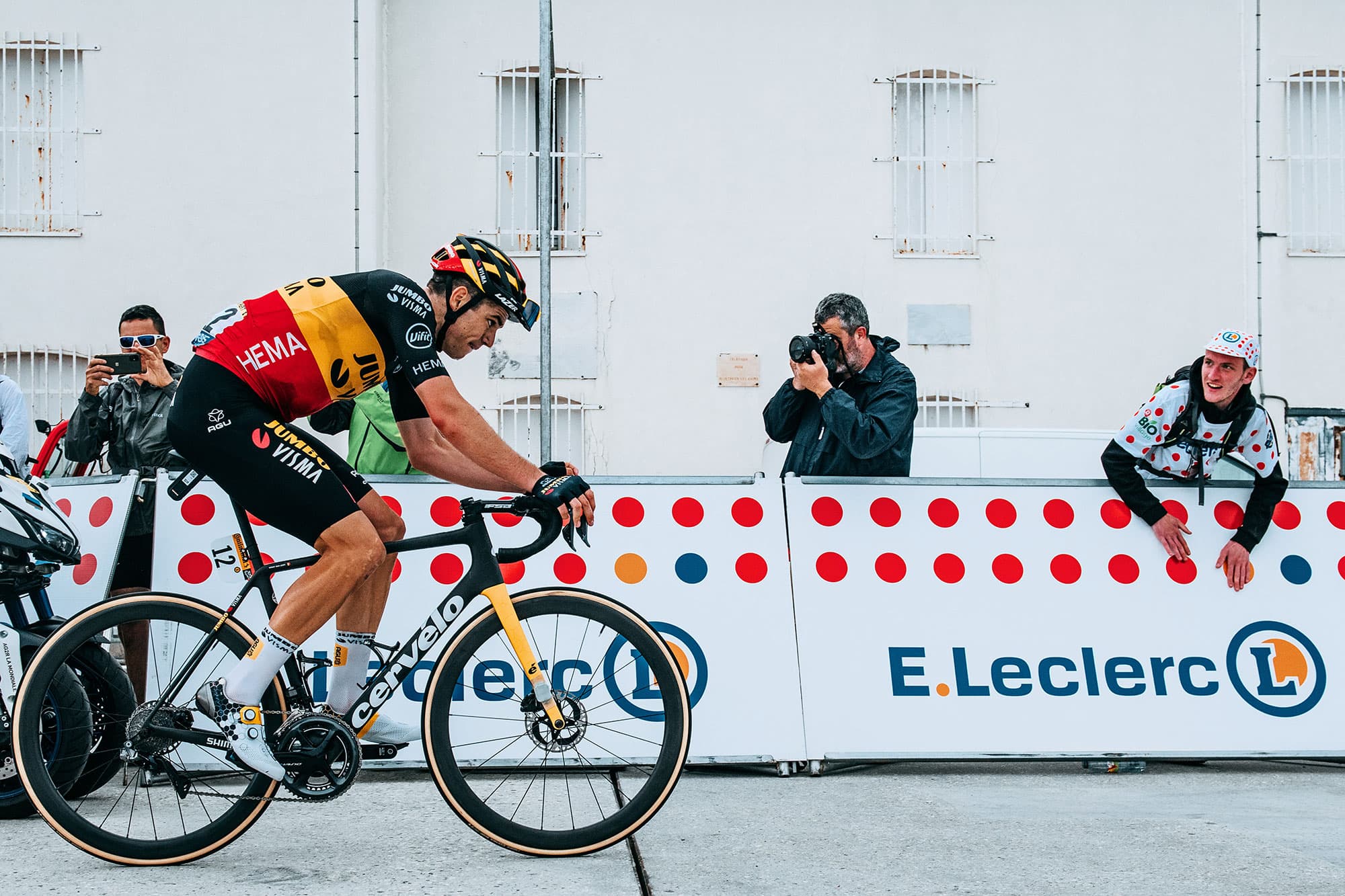
2024 Cervelo R5 Force eTap AXS
CerveloFaster in every direction
The new R5 frame is 130g lighter than the previous model—a 16% reduction from an already-light frame. And while aerodynamics weren’t a focus with this frame the way they would be on an S5 or P5, bringing the cables inside reduced drag by 25g.
Aerodynamic drag is the major factor affecting a bike and rider - it can account for up to 90% of the overall resistance that a rider must overcome. There are several types of drag relevant for us. First, pressure drag. As a body (in this case a bike and rider) passes through the air, it forces the air molecules to move out of the way in order to pass through them. These molecules push back on the body, creating pressure. The component of this pressure that faces aft (to the rear of the body) is called pressure drag.
Secondly, there is friction drag. Air, like all fluids, has viscosity (or "thickness"). The air molecules that come into contact with the body stick to its surface and stay stationary in relation to the body. As the body continues through the air, other air molecules pass by the stuck molecules as they flow around the body in layers, following parallel paths. This is the laminar boundary layer. The viscous nature of air creates a shear force, or friction drag.
At some point on nearly all bodies, laminar flow cannot be maintained and the air molecules tumble and mix instead of flowing smoothly. The transition point is where this turbulent boundary layer begins. This behaviour of flow is related to a parameter called the Reynolds number, which is determined by several physical characteristics of the flow. The laminar flow regime exists up to Reynolds numbers of around 10,000. Beyond Reynolds numbers of 10,000, the flow transitions to “turbulent” flow, as shown in the figure below.
Due to its mass, moving air has inertia and therefore cannot easily follow high-curvature surfaces. Under these conditions air separates from the body, creating low-pressure regions that "pull" on the surface, contributing to more drag. If the trailing edge of the body fails to guide the air neatly back together again, there is a “stalled flow” — a region of recirculating air that has low pressure. This low pressure again pulls on the surface, adding still more drag.
In designing our bikes and components to minimize aerodynamic drag, there are two different parameters we can affect. The first is the drag coefficient, which is a factor based on the shape of a body and how the air flows around it. Different shapes have different effects on drag. For example, a circular shape has roughly 24 times the drag of our TrueAeroTM tube shape. The orientation of the tube shapes to the airflow also affects its drag: the seat post and down tubes, for example, are presented at an angle, meaning the air hits a shape that’s closer to an ellipse, changing the drag coefficient.
The other parameter we can control is the frontal area. This is intuitive: the larger the area, the bigger the drag. Our engineers take this into account: for example, our time trial, triathlon and aero road bikes are designed so that the rider and bike (as an integrated system) present the smallest frontal area possible, for maximum aerodynamic advantage.
The drag coefficient, CD, and the frontal area, A, are related to the total drag a body sees by the following equation:
The other parameters in this equation are the velocity of the body through the air, V, and the density of the air, ρ (Rho). This is also the reason that many bicycle speed records attempts are made at high altitude, since the lower air density has a direct reduction on drag.
These aerodynamic forces are the largest source of drag on a bike and rider, up to 90% of the total resistance that they see. This means that designing our bikes and components to minimize drag, by minimizing both CD and A, is an efficient means of making the rider faster. However, minimizing the drag on the rider, through body position, component design or other means, is also important and so a systems approach is needed to ensure the fastest overall result. A bike never rides itself, and so we don’t design or test our bikes without a rider for this reason.
Further details on how our system approach to aerodynamics helps us to make the fastest bikes are available in our Aerodynamics Tech Paper.


Geometry
- Fork:
- Cervelo All-Carbon, Tapered R5 Fork
- Headset:
- FSA IS2 1-1/4 x 1-1/2
- Wheels:
- New Reserve 34/37mm Zipp 76/176 XDR, 20h (F), 24h (R), 22.6mm IW (F), 21.6mm IW (R), Center-Lock, Tubeless Ready
- Tires:
- Vittoria Corsa TLR G2.0 25c
- Crankset:
- SRAM Force AXS 48/35 with Power Meter
- Bottom Bracket:
- SRAM Dub
- Chain:
- SRAM Force, 12 spd
- Front Derailleur:
- SRAM Force eTap AXS 12 spd
- Rear Derailleur:
- SRAM Force eTap AXS 12 spd
- Cassette:
- SRAM Force 12s XG1270, 10-33
- Shifters:
- SRAM Force eTap AXS HRD 12 spd
- Handlebar:
- Cervelo HB13 Carbon
- Stem:
- Cervelo ST31 Carbon
- Brake Caliper:
- SRAM Force HRD
- Brake Rotor:
- SRAM Paceline 160mm
- Saddle:
- Prologo Scratch M5 PAS TiRox
- Seatpost:
- Cervelo SP20 Carbon Aero Post
- Accessories:
- Cervelo Faceplate Front Computer/Accessory Mount, Cervelo Rear Accessory Mount







